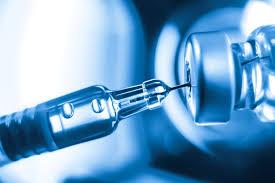Liberi tra i vivi
PROPONE:
COME DISINTOSSICARSI DAI "VACCINI" (sieri) COVID 19
Eccovi alcuni suggerimenti (molto importanti soprattutto ma non solo per il benessere dei nostri ragazzi incolpevoli):
-ESAMI DA EFFETTUARE:
1) VES:
Velocità di EritroSedimentazione (VES) è un indice infiammatorio.Come ricorda il suo stesso nome, questo esame misura la velocità con cui gli eritrociti (globuli rossi) - presenti in un campione di sangue reso incoagulabile - sedimentano sul fondo della provetta che li contiene.
2) PCR:
La proteina C reattiva (PCR) è un indice d'infiammazione; come tale, le sue concentrazioni nel sangue aumentano in presenza di processi flogistici di varia natura.
3) EMOCROMO con PIASTRINE:
detto anche esame emocromocitometrico, questo test consiste nella valutazione dei diversi parametri che si riferiscono ai principali componenti del sangue.
4) FIBRINOGENO:
detto anche "fattore I della coagulazione", è una glicoproteina plasmatica sintetizzata dal fegato con lo scopo di favorire l'emostasi (coagulazione del sangue).
5) D-DIMERO:
è un prodotto di degradazione della fibrina, una proteina responsabile della formazione di coaguli (trombi) nei vasi sanguigni.Quest'esame è particolarmente utile nello studio di patologie correlate all'eccessiva o inappropriata coagulazione.
6) test HRV:
Heart Rate Variability è un test capace di individuare le variazioni della frequenza cardiaca, che è il modo migliore per segnalare una alterazione del sistema nervoso autonomo.
-INTEGRATORI DA USARE:
1) Glutatione:
è un elemento incluso nella formazione e riparazione dei tessuti, nella produzione di sostanze chimiche e per il funzionamento del sistema immunitario.
2) N-acetilcisteina "NAC":
(Fluimucil: 200 mg 3 volte la settimana)
è un integratore che induce l'organismo a produrre glutatione, è noto come il precursore del glutatione e induce l'organismo a secernere glutatione per via endogena, proprio come accade quando si fa sport intensamente. NAC deriva dall'aminoacido L-cisteina e viene utilizzato dall'organismo per costruire antiossidanti. Gli antiossidanti sono vitamine, minerali e altri nutrienti che proteggono e riparano le cellule dai danni. Puoi ottenere NAC come integratore o farmaco da prescrizione.
3) Zinco:
in combinazione con NAC sono antiossidanti essenziali.
Altri integratori che possono essere assunti per aiutare il processo disintossicante sono:
4) Astaxantina
5) Melatonina
6) Cardo mariano
7) Tarassaco
Quercetina
9) Vitamina C
10) Vitamina D3 e K2 (da associare allo Zinco)
11) Semi di nigella
12) Magnesio
13) Curcumina
-FARMACI E TERAPIE
1) Cardioaspirina:
(1 compressa al giorno) per contenere l'effetto trombotico dei sieri genici.
2) Antiinfiammatori
3) Ivermectina
4) Ossigeno-ozono-terapia: agisce sui mitocondri, è regolatrice di alcuni aspetti del metabolismo del sangue e porta ossigeno.
-PRATICHE DA SEGUIRE:
1) Nutrizione: un’alimentazione a ridotto consumo di carboidrati.
2) migliorare la tolleranza allo stress (resilienza psico-fisica, psicobiologica): respirazione diaframmatica, pratiche di rilassamento, meditazione e preghiera.
✨️ 17 𝐐+
PROPONE:
COME DISINTOSSICARSI DAI "VACCINI" (sieri) COVID 19
Eccovi alcuni suggerimenti (molto importanti soprattutto ma non solo per il benessere dei nostri ragazzi incolpevoli):
-ESAMI DA EFFETTUARE:
1) VES:
Velocità di EritroSedimentazione (VES) è un indice infiammatorio.Come ricorda il suo stesso nome, questo esame misura la velocità con cui gli eritrociti (globuli rossi) - presenti in un campione di sangue reso incoagulabile - sedimentano sul fondo della provetta che li contiene.
2) PCR:
La proteina C reattiva (PCR) è un indice d'infiammazione; come tale, le sue concentrazioni nel sangue aumentano in presenza di processi flogistici di varia natura.
3) EMOCROMO con PIASTRINE:
detto anche esame emocromocitometrico, questo test consiste nella valutazione dei diversi parametri che si riferiscono ai principali componenti del sangue.
4) FIBRINOGENO:
detto anche "fattore I della coagulazione", è una glicoproteina plasmatica sintetizzata dal fegato con lo scopo di favorire l'emostasi (coagulazione del sangue).
5) D-DIMERO:
è un prodotto di degradazione della fibrina, una proteina responsabile della formazione di coaguli (trombi) nei vasi sanguigni.Quest'esame è particolarmente utile nello studio di patologie correlate all'eccessiva o inappropriata coagulazione.
6) test HRV:
Heart Rate Variability è un test capace di individuare le variazioni della frequenza cardiaca, che è il modo migliore per segnalare una alterazione del sistema nervoso autonomo.
-INTEGRATORI DA USARE:
1) Glutatione:
è un elemento incluso nella formazione e riparazione dei tessuti, nella produzione di sostanze chimiche e per il funzionamento del sistema immunitario.
2) N-acetilcisteina "NAC":
(Fluimucil: 200 mg 3 volte la settimana)
è un integratore che induce l'organismo a produrre glutatione, è noto come il precursore del glutatione e induce l'organismo a secernere glutatione per via endogena, proprio come accade quando si fa sport intensamente. NAC deriva dall'aminoacido L-cisteina e viene utilizzato dall'organismo per costruire antiossidanti. Gli antiossidanti sono vitamine, minerali e altri nutrienti che proteggono e riparano le cellule dai danni. Puoi ottenere NAC come integratore o farmaco da prescrizione.
3) Zinco:
in combinazione con NAC sono antiossidanti essenziali.
Altri integratori che possono essere assunti per aiutare il processo disintossicante sono:
4) Astaxantina
5) Melatonina
6) Cardo mariano
7) Tarassaco
Quercetina
9) Vitamina C
10) Vitamina D3 e K2 (da associare allo Zinco)
11) Semi di nigella
12) Magnesio
13) Curcumina
-FARMACI E TERAPIE
1) Cardioaspirina:
(1 compressa al giorno) per contenere l'effetto trombotico dei sieri genici.
2) Antiinfiammatori
3) Ivermectina
4) Ossigeno-ozono-terapia: agisce sui mitocondri, è regolatrice di alcuni aspetti del metabolismo del sangue e porta ossigeno.
-PRATICHE DA SEGUIRE:
1) Nutrizione: un’alimentazione a ridotto consumo di carboidrati.
2) migliorare la tolleranza allo stress (resilienza psico-fisica, psicobiologica): respirazione diaframmatica, pratiche di rilassamento, meditazione e preghiera.
✨️ 17 𝐐+
Liberi tra i vivi
🌾❤️🙏🔆🇮🇹
PROPONE:
COME DISINTOSSICARSI DAI "VACCINI" (sieri) COVID 19
Eccovi alcuni suggerimenti (molto importanti soprattutto ma non solo per il benessere dei nostri ragazzi incolpevoli):
-ESAMI DA EFFETTUARE:
1) VES:
Velocità di EritroSedimentazione (VES) è un indice infiammatorio.Come ricorda il suo stesso nome, questo esame misura la velocità con cui gli eritrociti (globuli rossi) - presenti in un campione di sangue reso incoagulabile - sedimentano sul fondo della provetta che li contiene.
2) PCR:
La proteina C reattiva (PCR) è un indice d'infiammazione; come tale, le sue concentrazioni nel sangue aumentano in presenza di processi flogistici di varia natura.
3) EMOCROMO con PIASTRINE:
detto anche esame emocromocitometrico, questo test consiste nella valutazione dei diversi parametri che si riferiscono ai principali componenti del sangue.
4) FIBRINOGENO:
detto anche "fattore I della coagulazione", è una glicoproteina plasmatica sintetizzata dal fegato con lo scopo di favorire l'emostasi (coagulazione del sangue).
5) D-DIMERO:
è un prodotto di degradazione della fibrina, una proteina responsabile della formazione di coaguli (trombi) nei vasi sanguigni.Quest'esame è particolarmente utile nello studio di patologie correlate all'eccessiva o inappropriata coagulazione.
6) test HRV:
Heart Rate Variability è un test capace di individuare le variazioni della frequenza cardiaca, che è il modo migliore per segnalare una alterazione del sistema nervoso autonomo.
-INTEGRATORI DA USARE:
1) Glutatione:
è un elemento incluso nella formazione e riparazione dei tessuti, nella produzione di sostanze chimiche e per il funzionamento del sistema immunitario.
2) N-acetilcisteina "NAC":
(Fluimucil: 200 mg 3 volte la settimana)
è un integratore che induce l'organismo a produrre glutatione, è noto come il precursore del glutatione e induce l'organismo a secernere glutatione per via endogena, proprio come accade quando si fa sport intensamente. NAC deriva dall'aminoacido L-cisteina e viene utilizzato dall'organismo per costruire antiossidanti. Gli antiossidanti sono vitamine, minerali e altri nutrienti che proteggono e riparano le cellule dai danni. Puoi ottenere NAC come integratore o farmaco da prescrizione.
3) Zinco:
in combinazione con NAC sono antiossidanti essenziali.
Altri integratori che possono essere assunti per aiutare il processo disintossicante sono:
4) Astaxantina
5) Melatonina
6) Cardo mariano
7) Tarassaco
Quercetina
9) Vitamina C
10) Vitamina D3 e K2 (da associare allo Zinco)
11) Semi di nigella
12) Magnesio
13) Curcumina
-FARMACI E TERAPIE
1) Cardioaspirina:
(1 compressa al giorno) per contenere l'effetto trombotico dei sieri genici.
2) Antiinfiammatori
3) Ivermectina
4) Ossigeno-ozono-terapia: agisce sui mitocondri, è regolatrice di alcuni aspetti del metabolismo del sangue e porta ossigeno.
-PRATICHE DA SEGUIRE:
1) Nutrizione: un’alimentazione a ridotto consumo di carboidrati.
2) migliorare la tolleranza allo stress (resilienza psico-fisica, psicobiologica): respirazione diaframmatica, pratiche di rilassamento, meditazione e preghiera.
🇮🇹❤️🙏
✨️ 17 𝐐+💪
0 Commenti
0 Condivisioni
1K Visualizzazioni










